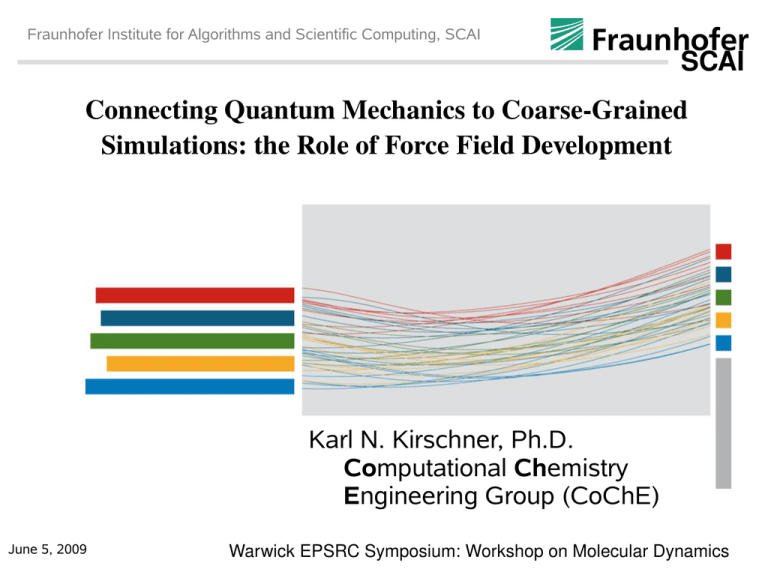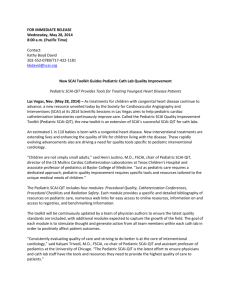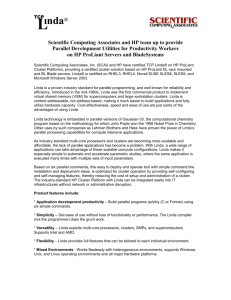SCAI Connecting Quantum Mechanics to CoarseGrained Simulations: the Role of Force Field Development Karl N. Kirschner, Ph.D.
advertisement

Fraunhofer Institute for Algorithms and Scientific Computing, SCAI SCAI Connecting Quantum Mechanics to Coarse­Grained Simulations: the Role of Force Field Development Karl N. Kirschner, Ph.D. Computational Chemistry Engineering Group (CoChE) June 5, 2009 Warwick EPSRC Symposium: Workshop on Molecular Dynamics Synopsis of SCAI and the “CoChE” Group Part of “Institutszentrum Birlinghoven” One of the largest computer science research centers in Germany SCAI Schloß Birlinghoven Campus SCAI: ~90 Employees + 40 PhD Students; highly interdisciplinary 2008 Annual budget : 8.6 Mio. Euro 40% of the SCAI budget from industry CoChE founded in 2007: 7 senior staff (PhDs), interdisciplinary 2 PhDStudents and 3-5 Undergraduates Universität zu Köln – Lehrstuhl Angewandte Mathematik / Wissenschaftliches Rechnen Bonn Aachen International Center for Information Technology Life Science Informatik (Prof. Hofmann-Apitius) June 5, 2009 DLR-SISTEC – Simulations- und Softwaretechnik (Leitung: Prof. U. Trottenberg, R. Hempel) Verteilte Systeme und Komponentensoftware Software QS und eingebettete Systeme 2 Talk Overview Force Fields: an old topic, but remains important SCAI Different routes / methods / philosophies exists for their development --- “The art of parameterization” Challenge: From our experiences and the data in the literature, can we begin to formulate more standard routes towards developing and optimizing a force field in a timely and reliable fashion? Why are we thinking about this? Industry applications & contribute to the scientific community. June 5, 2009 3 Soft matter - Multi-scaling modeling SCAI mesoscale time scale model model atomistic scale transfer quantum mechanics length scale transfer Force Fields SCAI What is the Current State? Basic atomistic force field equations appear to be established Type I Types: H=E FF + MD Type II Type III Molecular Classes: a) Functional/Small molecule (transferable) → Hydrocarbon, Alcohol, Esters... b) Specialized (nontransferable) → Solvent, Molecule specific c) Biological (something in between??) → Protein, DNA, Carbo. June 5, 2009 5 Force Fields. What is the Current State? Cont. Current research towards how to including additional quantum effects (eg polarization) SCAI Different routes exist towards developing new parameters Fully manual method Nearly full auto. method (target exp value) Cross terms Truncation of Fourier Series L.-J. Parameters Partial atomic charges (QM or empirical) QM – which levels Keep parameters close to chemical intuition vs completely adjustable Weighting specific molecular conformations How is experimental data used? a) training b) validation What exp observables are used -geom, energy, H˚vap Generic or Explicit torsion terms (eg X-Csp3-Csp3-X vs Csp3-Csp3-Csp3-Csp3) Different programs use different force fields (eg MM3, Parm99SB, GROMOS, and ports) Internal default settings effect the force field performance (eg scaling factors) Challenge: Develop a time-efficient and systematic route for new June 5, 2009 reliable parameters. 6 Soft matter - Multi-scaling modelling SCAI mesoscale time scale model model atomistic scale transfer quantum mechanics length scale transfer MM3, Glycam06 + Literature SCAI Current and future Goals via the lessons learned so far (atomistic) ● Have a Development and Validation suite of molecules ● Isolated chemical families for parameterization ● ● ● ● ● ● ● ● Use a basic form of the FF Equation, initially (eg no cross terms) Keep the number of atom types as low as possible Parameters should be transferable & program independent Remove 1-4 nonbonded & electrostatic scaling factors Use QM to develop the force field parameters (at least for version 1) HF/6-31G(d)//HF/6-31G(d) → Geometries MP2/ or B3LYP/6-31++G(2d,2p)//HF/6-31G(d) → Energies B3LYP/ or HF/aug-cc-pVTZ//HF/6-31G(d) → Electrostatics Partial Atomic Charge Sets → Ensemble averaged or Boltzmann weighted (via RESP) Explicit parameters (Csp3-Csp3-Csp3-Csp3 vs X-Csp3-Csp3-X) Final test of parameters is the comparison between theoretical and experimental results Provide a firm foundation for a) future parameter refinement, June 5, 2009 b) adding e lone pairs, and c) adding polarizability 8 Glycam06 Chemical Functional Groups: Hydrocarbons Alcohols Ethers Amides Carboxylates SCAI Ether Amides Alcohol Amides Ether Alcohols Ether Carboxylates Develop the parameters in a systematic stepwise fashion → allows the physics to be isolated to each parameter 1-4 Scaling Factors (AMBER) Why scaling factors: it was justified “given the known overestimation of short-range repulsion by a 6-12 form of potential.”† Why it is a problem: 1-5 interaction ≡ a 1-4 interaction (O•••O equal dist) captured by torsions parameters June 5, 2009 † Cornell et al. J. Am. Chem. Soc.. 115 (1993) 9631 & 115 (1995) 5179. ‡ Kirschner et al. J. Comput. Chem. 29 (2008) 662. 9 Partial Atomic Charges (P.A.C.) RESP Model† ● Input: QM ESP (CHELPG & large basis set) ● Uses a hyperbolic restraint (varied by a weighting factor) → purpose is to keep the P.A.C lower magnitude ● ● ● SCAI Helps to correct the high dependency of conformation in P.A.C. due to buried atoms Consistent P.A.C. in molecular fragments → allows for better generation of torsion parameters & L-J (?) Boltzmann Weighting vs Ensemble Averaging ● Boltzmann Weighting: gas-phase QM relative energies ● Ensemble Averaging: 1st approximationg to capturing solution-phase effects & conformations June 5, 2009 † Kollman et al J Phys Chem 97 (1993) 10269. 10 Ensemble Charge Set SCAI Do not need every atom to obtain a good RESP fitting to the ESP Charge are more chemically intuitive† For carbohydrates, removal of aliphatic hydrogens result in optimal number for fitting‡ ... this holds true for other compounds as well Methodology for final charge set (eg 100+ carbohydrate residues) RESP QM ESP 100 Conf. MD Simulation Boltzmann Weighted P.A.C. Ensemble Average Charge Set Take home point → a charge set that is less conformationally biased and reflexs the solution phase June 5, 2009 † Francl et al. J. Comput. Chem. 17 (1996) 367 & Glycoconjugate J. 14 (1997) 501. ‡ Basma et al. J. Comput. Chem. 27 (2001) 1125. ‡ Kirschner et al. J. Comput. Chem. 29 (2008) 662. 11 Glycam06 SCAI gg -D-GlcpOMe NMR (avg) Glycam06 gt tg gg June 5, 2009 JH5,H6R 5.4 5.41.7 9.51.4 2.31.6 1.01.0 3 gt tg JH5,H6S 2.3 2.92.0 1.81.2 9.01.9 1.61.1 3 12 GÅMESS mol2 geom antechamber Program interdependence... pdb babel cmpd at+q.prep mol2 cmpd at+q.prep parmchk pdb ELAN cmpd at+q.prep mol2conv mod ff residue lib update residue lib Convert FF FF tleap top & crd AMBER MIN/MD cmpd.itp edit FF leap.in top pdb awk top & pdb pdb2top Input & coords FF ...FF independence GROMACS MIN/MD Towhee MC Amber & Gromacs Methyl 2-methylpropanoate max. rms = 0.00494 Å June 5, 2009 SCAI max. rms = 0.0196 Å residues FF xyz top md_1.in target simulation TRIANA optimize equitest analysis data decide xyz md_2.in FF top Simulation analysis data md_3.in xyz simulation Top GRadientBased Optimization Workflow: GROW analysis data etc Efficient and timely generation of new models GROW† (opt of L-J parameters) SCAI Initial Parameters Gradient-based opt (Steepest Descent Newton Raphson Conjugate Gradient Trust Region) Current Parameters Calc. Physical Properties via MD Compare to Target Properties Good Final Parameters June 5, 2009 Comparison is done by evaluating the loss function d Bad F y=∑ ∑ i =1 T ∈T f exp i ,T sim i ,T exp i ,T −F f y ∇ F y=0 † Hülsmann et al J Comput. Chem Submitted & Hülsmann et al Comp Phys Comm submitted 2 Soft matter - Multi-scaling modeling SCAI mesoscale time scale model model atomistic scale transfer quantum mechanics length scale transfer SCAI FF Convert FF FF tleap top pdb awk top & pdb pdb2top FF top & crd AMBER MIN/MD data Input & coords GROMACS MIN/MD analysis analysis Towhee MC data FF Refine atomicstic FF? June 5, 2009 Coarse Graining analysis data analysis data SCAI Atomistic model Number of polymers: 59 Number of monomers per molecule: 8 Number of atoms: 7375 Temperature: 450 K CG model Number of beads: 472 Number of different type of the beads: 3 The C2 position has been chosen as center of the beads June 5, 2009 2 3 1 19 SCAI 2 3 Angle 2-2-2 1 Bond 2-2 Inter-RDF 2-2 We reproduce atomistic MD target distributions June 5, 2009 for inter- and intramolecular interactions 20 ESPResSo++ SCAI ESPResSO: Extensible Simulation Package for Research on Soft matter, MPI for polymer research (MPIP), Mainz Open source, users in about 100 institutes all over the world ESPResSo++: collaborative project of MPIP and Fraunhofer SCAI Integration scheme: ● Standard MD (velocity-Verlet, constant energy) ● MD with constant T (eg Langevin) or constant P Interactions ● Lennard-Jones, Morse, Gay-Berne (ellipsoids), tabulated potential ● Harmonic or nonlinear expander bonds, angle potentials, dihedrals Spatial constraints: walls, spheres, cylinders Electrostatics; Hydrodynamics via Lattice-Boltzmann; Analysis June 5, 2009 21 Summary FF Generation + Opt a) Isolate chemical functionalities b) Explicit parameters c) No nb or el 1-4 scaling d) RESP: Boltzmann, Ensemble Averaging e) In-house scripts SCAI ? Hydrocarbon (un- saturated), Alcohols, Ester, Ethers, (Amides) Program Independent a) AMBER, GROMACS, Towee, etc. b) In-house script converters for FF, residue lib., etc. c) Must test FF performance – min & MD Coarse Graining a) Collaboration b) ESPResSo++ FF Refinement a) TRIANA Workflow to automate job cycle b) GROW: parameter optimization towards target goal June 5, 2009 22 Acknowledgments & Coworkers Marco Hülsmann Viktoria Nakhoumovich Thorsten Köddermann Thomas Brandes SCAI Kathrin Heikamp Andreas Bittracher Tatjana Aab Anton Schüller Gerd Winter Dirk Reith Glycam06 Robert Woods (UGA) Sarah Tschampel (UGA) Austin Yongye (UGA) June 5, 2009 Astrid Maa Axel Arnold Ferag Selim Coarse Graining Florian Müller-Plathe (TU Darmstadt) Elena Algaer (TU Darmstadt) Ali Karimi (TU Darmstadt) Funding: NIH, NSF, PNNL 23



